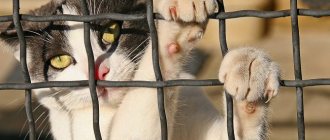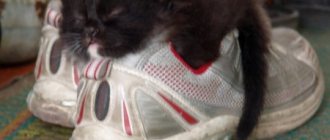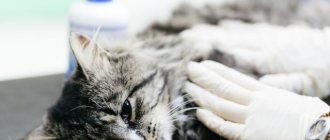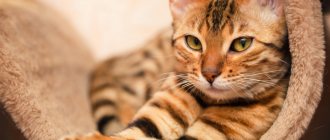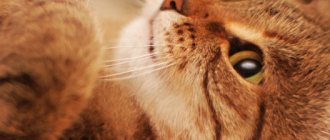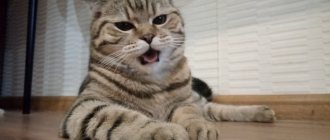A cat's life is not always smooth sailing. The reasons that cause nervousness, tension or aggression in a furry pet are different. Any sign of stress in a cat is a danger signal. An animal in this state requires help, since the consequences of an unbalanced emotional background can manifest itself in the form of serious health problems.
Common Causes of Stress in Cats
global $ads_google; //data-ad-slot=”2475549904″ $ads_google = empty($ads_google) ? false : true; ?> if ($ads_google == false) {?>
$ads_google = true; ?> } ?>
Stress is a psychological reaction in response to a negative change in living conditions. A pet living in a loving and calm, stable environment rarely experiences emotional turmoil. However, any factor that disrupts his measured life can cause severe suppression or, conversely, hyperactivity.
The tension that arises in the nervous system manifests itself at the physical, psycho-emotional and behavioral level. The reasons that cause stress in a cat may be related to a change in environment, illness, physiological changes, or irritants in the external environment.
Moving
Changing homes is one of the most stressful factors for cats. Familiar surroundings and familiar smells are a guarantee of safety for the animal. When moving, the pet perceives its new place of residence as a potential threat. He needs time and effort to familiarize himself with the new territory. If during this period you do not surround the cat with care, attention and objects familiar to him, the risk of a stressful situation is very high.
Emotional
Stress in a cat can cause strong emotions. The reasons for their occurrence lie in life circumstances. Melancholy is initiated by departure or change of owner, conflicts in the house, or putting an animal into foster care. A trip to the veterinarian is associated with danger and causes anxiety. The situation is aggravated if previous visits to the veterinary hospital were associated with pain and negative emotions.
Signs of stress may appear in a pet if a new four-legged neighbor has appeared in the family. Not all cats adequately accept a dog in the house; it can be difficult for two cats to get along in the same territory. Stress in a cat can take the form of jealousy, rejection, protest, and mischief. The reason for a surge of emotions can be swimming, getting a haircut, or participating in an exhibition.
Diseases and physiology
Psychological sensitivity increases during pregnancy and nursing kittens. The cat's entire attention is aimed at preserving the offspring, so she perceives any potentially dangerous factor very acutely. Temporary physical incapacity of a pregnant female also leaves its mark when she cannot fully ensure her safety.
Special causes include illness. Any blow to health affects the psychological state. The animal becomes physically and emotionally more vulnerable. The inability to stand up for itself due to physical disability puts the cat under stress. Even problems such as fleas, ticks, worms, and fungal dermatitis can provoke itching, increased excitability, or, conversely, severe depression.
If your pet experiences pain or discomfort due to illness, the risk of stress increases significantly.
External factors
External reasons include home renovations, extraneous noise, changing furniture, parties with a large number of guests. Excessive fuss, strong odors, harsh sounds - all this affects the cat’s nervous system, causing stress. The situation is aggravated if in such an environment the owner does not have enough time for attention and affection for the animal. Even a short-term unpleasant influence from the outside can cause severe fear in the animal. And if the irritating factor is repeated, then nervousness is guaranteed.
What to do when your cat is nervous
Having an idea of the signs of increased nervous excitability, the owner is able to prevent the development of a nervous system disorder in a pet in a stressful situation (moving to a new place, traveling on public transport or by car, the arrival of a new family member or the arrival of guests, etc.).
In car
Some cats take the forced journey hard: they scream heart-rendingly, rush around the carrier, and try to escape. The animal’s fear is caused by a change in the usual environment, many new unfamiliar smells, and sharp sounds. In public transport, in addition to the smells and sounds of the car, numerous odors of strangers are added, which frightens the animal even more.
Car panic in a furry couch potato can last for hours, exhausting the animal itself and causing inconvenience to the owner. The cat develops increased salivation, rapid breathing, increased heartbeat, and muscle tremors.
The pet does not respond to its name, does not respond to affection, and does not accept treats. This behavior indicates a panicked state of the animal and requires assistance.
First of all, knowing about his pet’s fear of vehicles, the owner should accustom the cat to traveling gradually : first, just let him sit in the car, getting used to the smell, then stay in the car with the engine on, and drive a short distance. It is better to accustom your furry family member to travel from a young age.
When transporting a cat in a car, it is necessary to use a special carrier. A plastic container that provides air circulation to the animal is best suited for this. It can be secured in the back seat using seat belts. Under no circumstances should you carry a nervous animal in your arms. The cat's reaction is unpredictable; it can scratch, break out, get under the pedals and cause a traffic accident.
Carrying for cats and cats in the car
If a long trip is necessary, the owner should consult a veterinarian regarding the use of sedatives. Some products should be used in advance to achieve an optimal calming effect, for example, Fitex, based on herbal components.
In especially severe cases, they resort to injections of sleeping pills, for example, Vetranquil, Butorphanol, Relanium. The need to use a sleeping pill and the choice of drug should be carried out only by a veterinary specialist.
At home
Nervous breakdowns await the furry homebody not only in an unfamiliar place and during transportation. A pet can also feel fear and aggression within its own walls: when a new family member or animal appears, when guests visit, when new furniture appears, etc.
An animal that is under stress radically changes its behavior: it begins to bite, scratch, and does not allow itself to be touched or stroked. Neurosis can manifest itself by leaving marks on the territory. Often a cat hides in the farthest and darkest corner and does not come out for days. Trying to get out of hiding leads to worsening panic attacks.
We recommend reading about why cats love valerian. You will learn about the effect of the drug on animals, whether it is possible to give valerian to cats, and why not everyone likes it. And here is more information about how to stop a cat from biting.
Symptoms of stress
You can find out that a cat is in an unbalanced psychological state by its characteristic signs. Experts distinguish three phases of stress in a cat: anxiety, resistance and exhaustion. Each stage is characterized by a certain strength of manifestation and its own symptoms of stress.
global $ads_google; //data-ad-slot=”2475549904″ $ads_google = empty($ads_google) ? false : true; ?> if ($ads_google == false) {?>
$ads_google = true; ?> } ?>
First stage
When a stress factor appears, the cat begins to experience anxiety. This stage often goes unnoticed by inattentive owners.
However, with close communication with your pet, you can still notice the first signs of stress. During this period, the cat experiences:
- decrease in body temperature;
- lowering blood pressure;
- cardiopalmus;
- shallow rapid breathing;
- tremor of the whole body or its individual parts;
- changes in appetite and taste preferences;
- increased licking of fur;
- excessive salivation;
- apathy or, conversely, aggression;
- frequent meowing, hissing, or other sounds;
- involuntary urination;
- ignoring the litter tray;
- occasional
diarrhea or constipation.
These signs of stress can appear together or be combined in different combinations.
Second stage
The resistance (counteraction) phase is associated with the body’s attempts to return to a physiologically normal state. If at this stage the owner recognizes the cause of stress in time and the irritant is eliminated, then the symptoms gradually disappear. The functioning of all body systems is restored, and the psycho-emotional background returns to balance.
If stress continues to affect the animal, the body tries to adapt to it. Energy consumption becomes more economical compared to the first stage. Changes occur at the endocrine and hormonal levels. Outwardly, it may seem that the cat is accustomed to the situation and is not suffering. In reality, the body’s metabolism changes dramatically at this time and the third phase of stress begins.
Third stage
global $ads_google; //data-ad-slot=”2475549904″ $ads_google = empty($ads_google) ? false : true; ?> if ($ads_google == false) {?>
$ads_google = true; ?> } ?>
Constantly keeping a cat under stress leads to the body's vital reserves being depleted. Functional systems cannot cope with increased load. A lack of proteins, fats, and carbohydrates provokes an increased consumption of one’s own reserves. Against this background, general exhaustion begins. Signs of stress at this stage are complete apathy, constant passivity, and a noticeable loss of appetite. The animal rapidly loses weight and dystrophy begins.
Symptoms that require you to see a doctor
Not every stress and its impact on a pet should cause anxiety for the owner. A healthy cat copes with a stressful situation quite quickly on its own. However, there are symptoms that require the owner to show the pet to a veterinarian. These clinical warning signs include:
- constant licking of the fur until it is wet;
- agitation, hyperactivity, jumping for no reason, hunting for imaginary prey, beating the air with paws, colliding with objects, hitting walls;
- aggression, hostility towards the owner and household members;
- fear and panic of familiar things;
- increased reaction and excitability to familiar sounds, rustles, smells, things;
- depressed state, apathy, detached gaze at one point, lack of response to external stimuli;
- clonic-tonic convulsions;
- changes in heart rate and breathing.
After a clinical examination, your veterinarian will perform specific physical tests to look for abnormal neurological responses.
To exclude neoplasms and other pathologies, X-ray and ultrasound examinations, general and biochemical blood tests are used. Magnetic resonance therapy helps in making a diagnosis. Based on the results of the examination, a consultation with a neurologist is scheduled.
Chronic stress
A constant or periodically occurring stress factor puts a cat in a state of chronic tension. The animal's behavior changes and there are signs of physiological disorders. The pet tries to hide in a secluded place where no one can disturb it. Solitude is accompanied by increased drowsiness, weakness, and reluctance to play or show any activity. At the same time, a cat may react inadequately and even aggressively to loud unexpected sounds.
Bouts of gluttony or, conversely, ignoring food also indicate an ongoing chronic process. Cats often begin to mark the house, defiantly leaving puddles in different rooms or even near the bowl. Thus, the animal tries to demonstrate its dissatisfaction or fear.
Biochemical changes occurring in the body contribute to hair loss. This is accompanied by an excessive desire for hygiene, which causes the cat to constantly lick itself. As a result of prolonged neurosis, bald spots appear on the body, the hair becomes dull and thins.
Diagnostics
At the veterinary clinic, the cat will be examined: its reflexes, gait, eyes will be checked and its reaction to pain will be assessed. Be prepared to present your pet's medical history to the doctor.
Sometimes additional blood and urine tests and examination of the thyroid gland are required to exclude feline hyperthyroidism, which manifests itself with mild neurological signs. The cat's blood pressure will be taken.
Radiographs (X-rays) of the limbs and spine reveal spinal injuries and large tumors. If your regular veterinarian is unable to determine the exact cause of the disease, consult a neurologist, who may recommend more advanced imaging such as an MRI or CT scan, which can detect tumors of any size, inflammation and other abnormalities.
Feline coronavirus
If necessary, the cerebrospinal fluid is analyzed to identify infectious agents, blood and abnormal cells.
What are the dangers of stress for cats?
It has been scientifically proven that many serious disorders in an animal’s body begin against a background of fear and nervous disorders. Practice confirms, for example, that such a rare phenomenon as pulmonary edema occurs precisely against the background of severe mental shock. A veterinarian anesthesiologist talks in more detail about all the dangers of stress in cats:
Anorexia
Refusal to eat provokes a lack of nutrients necessary for the normal functioning of the body. First of all, the digestive system is impaired. Insufficient nutrition provokes disruptions in the functioning of the stomach, intestines, and liver. The risk of gastritis, ulcers, and skin diseases increases. Prolonged stress threatens complete exhaustion. Lack of nutrients initiates cellular catabolism. After complete consumption of fat reserves, the breakdown of body proteins begins. The animal becomes painfully thin.
Cystitis
The genitourinary system in cats, like in other living organisms, is subject to neurohumoral regulation. Inhibition processes in the nervous system contribute to urination disorders. As a result of a nervous disorder, the pet may miss timely urges to go to the toilet. In the presence of accompanying factors, urinary retention in the bladder contributes to the development of bacterial flora. This often causes cystitis. In such a situation, it is necessary to treat not only the cat’s nervous system, but also inflammation of the bladder.
Constipation
global $ads_google;
//data-ad-slot=”2475549904″ $ads_google = empty($ads_google) ? false : true; ?> if ($ads_google == false) {?> $ads_google = true; ?> } ?> Often, moving, the arrival of a new tenant in the house, or overexposure cause physiological constipation in a cat. Impaired intestinal motility is one of the common consequences of stress in cats. Chronic constipation, in turn, is dangerous due to colic, obstruction of the intestinal tube, and inflammation.
In some cases, stress in a cat increases gastrointestinal motility and manifests itself in the form of diarrhea.
Other consequences
Neuroses affect the immune system, which provides protection against viruses, pathogenic bacteria, and fungi. This is especially dangerous for small kittens, who, due to their age and incomplete immunization, are less resistant to various infections.
Neuroses threaten the cat's cardiovascular system. Rapid heartbeat, sudden rushes of blood due to attacks of fear, increased blood pressure contribute to the development of heart and vascular diseases. As a result, the general blood supply to the body is disrupted.
Can a cat die from stress?
Many owners do not attach much importance to cat fears, considering them temporary and harmless phenomena. In the first and second stages, when stress in a cat manifests itself in the form of behavioral and physiological symptoms, there is no threat to life. However, the third stage of neurosis is considered extremely dangerous for a pet. Metabolic disorders entail complete depletion of the body's internal reserves. A protracted pathological process that is ignored by the owner is dangerous and fatal.
leave a comment
Neurological Disorders in Cats
are divided into disorders of the nervous system and disorders of the brain. Certain neurological disorders are hereditary genetic in nature, while others develop under the influence of the environment (such as the presence of toxic substances), trauma and damage. Cats suffering from neurological disorders exhibit unusual symptoms, which cat owners often cannot recognize as signs of the disease, but mistaken for “wrong” behavior, scolding the unfortunate animal. Neurological disorders vary in severity, and some can even cause sudden collapse and death. Cats with neurological disorders require additional attention and supportive care. Appropriate medications also help control symptoms and prevent the disease from progressing.
The most common neurological disorders in cats can be divided into the following types:
- Diabetic neuropathy
- Myasthenia gravis
- Hyperthyroidism (Hyperthyroidism) associated with neurological problems
- Epilepsy
Treatment of stress in cats
To bring a cat out of stress, a set of measures is needed. It includes psychological assistance from the owner and medications. Most often, non-hormonal sedatives for stress are used in therapy. But first of all, it is necessary to identify the cause and, if possible, remove or reduce the impact of the stressor.
Psychological and behavioral therapy
The technique consists of increasing attention to the pet and using games. Animal psychologists recommend using the distraction method. The owner’s task is to switch the cat’s attention from the object of stress to the toy. It is most convenient in such a situation to use interactive moving objects.
Another technique is immersion, which is considered more difficult. Real stress conditions are created for the pet, but the situation is kept under control. This switch helps level out the symptoms of the previous disorder. But this method requires great care and scrupulousness on the part of the person, otherwise the animal’s condition can only worsen.
Training helps relieve stress. The artificial creation of obstacles and difficulties that need to be overcome physically forces the cat to mobilize its strength. If it is impossible to eliminate the cause of stress (for example, canceling a move), it is worth surrounding your pet with care and affection. Frequent stroking, talking to your pet, and offering your favorite treats help you get through the adaptation period faster.
Medication assistance
global $ads_google; //data-ad-slot=”2475549904″ $ads_google = empty($ads_google) ? false : true; ?> if ($ads_google == false) {?>
$ads_google = true; ?> } ?>
The modern range of medications used for neuroses in cats includes sedatives, vitamins, and preparations with pheromones. They are available in the form of drops, aerosols, and tablets. In pet stores you can find special collars with anti-stress impregnation.
The following have antidepressant effect:
- Bach flowers
. A set of homeopathic plant extracts with different effects. To relieve stress, essences from agrimony, aspen, clematis, poultry and other plants are recommended.
- Stop stress
. The sedative contains phenibut and extracts of peony, skullcap, motherwort, mint, hops, and valerian. Biologically active substances normalize brain functions.
- Cat Baiyun
. A natural remedy for stress from medicinal plants: mint, valerian, sweet clover, oregano, thyme, lemon balm. Available in tablet and liquid form.
- B vitamins
. They improve the conduction of nerve impulses and help normalize the psychosomatic state. Vitamins do not cure, but provide good support for anti-stress medications.
At home, it is easy to prepare herbal infusions and decoctions from soothing herbs (oregano, mint, lemon balm). Essential oils of plants are used as fragrances for the room in which the cat is located. The esters of lavender, neroli, mint, and bergamot have the best effect.
It is advisable to consult a veterinarian before starting treatment for stress with medications.
Diseases of the nervous system of cats
Diseases of the central nervous system of cats are very diverse and can be caused either by direct damage to the nervous tissue itself or as a consequence of some systemic lesions. Such as hepatitis or hormonal disorders.
Aggression
The most common and frequent symptom of many neurological diseases. A behavioral disorder that can be a completely normal condition during periods of “hunting,” pregnancy or lactation. This problem is solved by hormonal therapy or sterilization. In most cases, periods of aggression pass on their own without medical help.
But the aggressiveness of cats may be a consequence of any disease, infection in particular. You should be especially wary if the cat's behavior has changed suddenly. This often speaks in favor of rabies. During this period, it is necessary to protect all family members from possible scratches and bites, and create a calm environment around the pet.
If these measures do not help, you should immediately contact your veterinarian.
Neurotic conditions are reversible disorders that occur in the functioning of higher nervous activity. They develop against the background of stress, conflict situations, insufficient attention or aggression on the part of the owner, frequent exhibitions, less often infectious complications, etc. Neurotic states are a kind of collective image.
In cats, hysterics, depression or neurasthenia are most often observed. They manifest themselves as two completely opposite symptom complexes. In one case, the cat may be overly aggressive, reacting too strongly to completely normal or weak stimuli. She may develop seizures and even disturbances in the functioning of the cardiovascular system.
In another case, the cat becomes lethargic, apathetic, weakly reacts to external stimuli, and drowsiness.
First aid consists of creating the most comfortable conditions for the pet, keeping it in a darkened room.
Kay-Gaskell syndrome is also called dysotonomia. It is extremely rare and its causes are unknown. The mechanism of action is not fully understood, and treatment is ineffective in most cases. Presumably the peripheral nervous system is affected, so almost all organs are affected.
At the same time, the respiratory, urinary, digestive and visual systems are involved in the process. There is an alternation of constipation and diarrhea, mydriasis and prolapse of the third eyelid, urinary and fecal incontinence and overdense mucous membranes. In these cases, self-medication is detrimental and urgent veterinary care is required.
The success of treatment depends on how timely assistance was provided.
Discopathy
This term includes all secondary lesions and compression of the spinal cord that develop as a result of spinal injuries. Discopathies occur as a result of injuries, falls, unsuccessful turns and jumps. In kittens, discopathy develops against the background of congenital or acquired diseases of bone tissue and skeleton. Most often it is rickets.
Symptoms for discopathy are different and depend on the location of the lesion. Sometimes an unnatural arrangement of the vertebrae and a curved spine are visually determined. Sharp pain may be present, normal movements are impossible or difficult, if the lower segments are affected, paresis and paralysis develop, defecation and urination are impaired.
The success of treatment depends on the extent of the lesion. Only carried out by a veterinarian.
Meningoencephalitis
Meningoencephalitis is an inflammation of the brain and meninges. Most often it is the result of a viral infection, less often bacterial. Viruses cause serous meningoencephalitis, which is easier to treat and goes away with virtually no consequences.
Bacteria cause purulent meningitis, which is difficult and long to treat, and after it there are multiple residual effects, often uncorrectable. Symptoms depend on the location of the lesion and its extent. Impaired consciousness develops.
The cat becomes either overly active and aggressive, or lethargic and drowsy. Vomiting, cramps, muscle tension, etc. may occur. Breathing is often disrupted - fast and shallow or deep and very rare. If these symptoms occur, be sure to call a veterinarian.
Before his arrival, place the cat in a dark room without irritants.
Stroke and heart attack mean an acute disorder of cerebral circulation. With cerebral ischemia, a heart attack develops. A blockage of a blood vessel occurs with a thrombus, as a result of which the area of the brain supplied by this vessel is left without power and dies.
With hemorrhagic strokes, the vessel ruptures, causing hemorrhage - apoplexy. Strokes and heart attacks occur in the vast majority of cases in older cats. Symptoms depend on the extent of the damage. They develop paralysis and paresis, possible breathing problems and urinary defecation. Treatment is prescribed by a doctor.
The sooner treatment is started, the greater the likelihood that it will be possible to partially or completely restore lost functions.
Hepatargia develops against the background of severe liver failure, impairment of basic liver functions, sepsis, severe infections and some other conditions. The mechanism of development is not fully understood, but it is believed that the main role is played by the increased amount of ammonia released during the diseases listed above, which has a neurotoxic effect.
Under the influence of ammonia, foci of softening (ischemic encephalopathy) are formed in the brain tissue, and depending on their location, one or another symptomatology predominates. The main symptoms are neuropsychic - behavioral disorders, which progress over time. There is also a specific smell from the mouth - sweetish-smelly.
Without the necessary amount of veterinary care, hepatic coma develops.
Paralysis and paresis
Paresis is partial inhibition of motor and tactile sensitivity, paralysis is complete.
These conditions develop against the background of injuries, bruises, strokes, as well as diseases leading to complete or partial restriction of blood supply to the brain.
The affected limb may be atonic, flabby and atrophied or, on the contrary, in strong tone. It is recommended to keep the paw warm at all times, carry out warming procedures, and paraffin therapy.
Concussion
A concussion develops as a result of injury. Manifested by loss of consciousness, vomiting, impaired coordination of movements, loss of appetite, apathy, rapid pulse. At the first stage of first aid, complete rest and cold head are recommended. Position the cat on its side, in this case it is necessary to ensure that the tongue does not sink, and if breathing stops, restore it artificially.
Epilepsy
In epilepsy, organic lesions of the brain, in particular the frontal lobe, are observed. The disease is characterized by convulsions and seizures of varying severity and duration. Unfortunately, the disease is incurable and with the help of a veterinarian you can only reduce the number of seizures or eliminate them for a while.
There are two forms of epilepsy: true and false. True epilepsy is the epilepsy itself, while false epilepsy develops against the background of some disease, when cured, the seizures stop on their own.
We suggest you read: How to treat subcutaneous mites in cats at home
Eclampsia
Eclampsia affects only pregnant or lactating cats. Moreover, this is either the last period of pregnancy or the first week after childbirth. This is due to the fact that the level of calcium in the blood decreases and edema begins to form. Eclampsia is characterized by tonic-clonic convulsions, palpitations, elevated blood pressure, impaired coordination of movements, etc.
In conclusion, I would like to note that neurological diseases necessarily require the intervention of a veterinarian, and the sooner this happens, the greater the chances of successful treatment.
Diseases of the nervous system are widespread in cats. Typically, such diseases include damage to the central nervous system, peripheral nerves and spinal cord.
The most common cause of nervous system diseases is injury. They can cause damage to the spinal cord and nerve endings.
For the central nervous system, viral and bacterial infections are most often the main cause.
Neurological disorders are also observed with hormonal diseases. An example of such ailments is neuropathy due to diabetes mellitus and hyperthyroidism.
Possible changes in behavior due to liver complications - hepatic encephalopathy.
- Neuropathy in diabetes mellitus - if the animal has a history of diabetes mellitus, then one of the complications of high blood sugar is degenerative changes in the peripheral nerves. With neuropathy, weakness of the hind limbs, problems with walking and supporting one's paws are observed.
- Myasthenia gravis is caused by a violation of the passage of nerve impulses to the muscles. The main ones affected are the chewing, swallowing and oculomotor muscles, although the respiratory muscles and diaphragm may also be involved in the process. When the last muscle groups are affected, complicated pneumonia and respiratory disorders may occur, even to the point of stopping.
- Hyperthyroidism – occurs against the background of increased levels of the hormone TSH in diseases of the thyroid gland. Expressed in muscle pain, tremors, changes in behavior (nervousness, increased activity, irritability).
- Epilepsy is perhaps the most common neurological disease. Accompanied by convulsive syndrome, which seriously affects the health of the cat and can lead to death from suffocation.
- Inflammation of the membranes of the brain - accompanied by a significant increase in temperature, increased excitement which then changes to depression, tension in the muscles of the back of the head. Convulsions and coma may develop.
Treatment
In most cases, neurological diseases are chronic, so their therapy is accompanied by lifelong drug support.
It is definitely worth arranging the animal’s life - its place should be in a warm room without unnecessary noise and irritants. If you have problems with mobility, it is recommended to limit physical activity.
You should definitely include dairy products in your diet, as well as taking additional multivitamin complexes.
Preventing cat stress
It is impossible to completely protect your furry pet from unpleasant factors. But it is within the power of a person to prepare an animal for possible stress. Prevention should begin when the kitten first appears in the house. To do this, various non-standard situations are created for the pet. But they must always be supervised by the owner. Traveling together, meeting new people, communicating with fellow animals - all this expands the emotional sphere of a cat.
A good way to prevent stress for a cat is constant communication. At the same time, games and affection should not be against the will of the pet, as this causes protest and discontent in him. Any travel, grooming event, move, or noisy holiday must be preceded by preparation. This could be the dosed use of a sedative, preliminary acquaintance with people or a new place.
If you follow all the rules of prevention, you can prevent the development of neurosis in your pet. If a critical situation does arise, then at the first symptoms of stress it is necessary to take urgent measures. Psychological assistance in combination with official therapy can relieve symptoms and bring the animal out of a stressful state.
global $ads_google;
//data-ad-slot=”2475549904″ $ads_google = empty($ads_google) ? false : true; ?> if ($ads_google == false) {?> $ads_google = true; ?> } ?>
